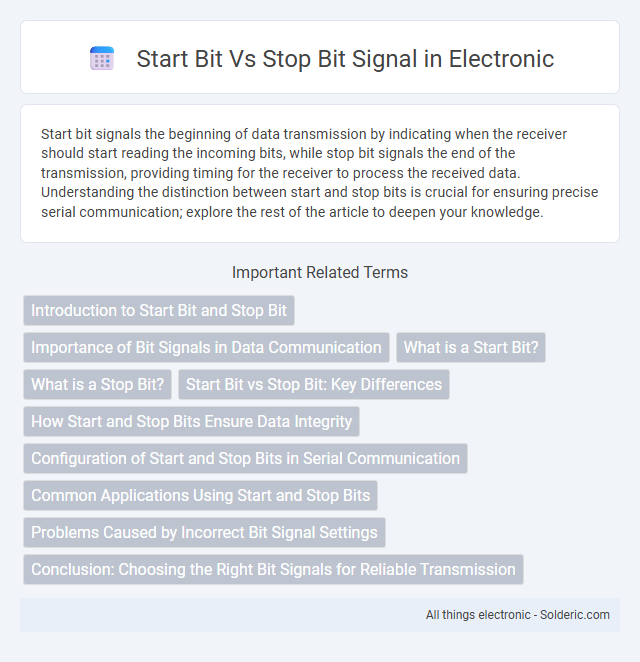Start bit signals the beginning of data transmission by indicating when the receiver should start reading the incoming bits, while stop bit signals the end of the transmission, providing timing for the receiver to process the received data. Understanding the distinction between start and stop bits is crucial for ensuring precise serial communication; explore the rest of the article to deepen your knowledge.
Comparison Table
| Feature | Start Bit | Stop Bit |
|---|---|---|
| Purpose | Indicates the beginning of a data packet | Indicates the end of a data packet |
| Signal Level | Logical 0 (Low) | Logical 1 (High) |
| Duration | Typically 1 bit time | 1, 1.5, or 2 bit times depending on configuration |
| Function | Synchronizes receiver to start reading data | Marks frame end and allows receiver to process data |
| Presence | Always present at frame start | Always present at frame end |
| Standard Context | Asynchronous serial communication | Asynchronous serial communication |
Introduction to Start Bit and Stop Bit
Start bit and stop bit are essential components in asynchronous serial communication, marking the beginning and end of a data frame respectively. A start bit signals the receiver to prepare for incoming data by transitioning the line from idle to active, typically represented by a logic low level. The stop bit follows the data bits, returning the line to an idle state with a logic high level, ensuring proper synchronization and allowing the receiver to recognize the frame boundary.
Importance of Bit Signals in Data Communication
Start bit and stop bit signals are crucial in asynchronous serial communication for framing data packets, ensuring accurate synchronization between the transmitter and receiver. These bits mark the beginning and end of each byte, preventing data collision and enabling your devices to interpret incoming signals correctly. Proper use of start and stop bits enhances data integrity, minimizes transmission errors, and optimizes communication efficiency across digital networks.
What is a Start Bit?
A start bit is a signal used in asynchronous communication to indicate the beginning of a data frame, allowing the receiver to synchronize with the incoming data stream. It is typically a low voltage level transition that alerts the receiving device to prepare for the upcoming data bits. The start bit ensures accurate timing and proper decoding of each byte transmitted.
What is a Stop Bit?
A stop bit signals the end of a data packet in serial communication, ensuring the receiver recognizes the completion of transmission. It follows the data bits and can have a duration of one, one and a half, or two bit periods, providing timing for synchronization between devices. Your communication system relies on a correctly timed stop bit to distinguish separate frames and maintain data integrity.
Start Bit vs Stop Bit: Key Differences
Start bit signals mark the beginning of a data transmission, indicating the receiver to prepare for incoming bits, while stop bit signals signify the end of a data packet allowing synchronization for the next byte. The start bit is typically a low voltage (0) transition from the idle high state, whereas the stop bit returns the line to a high voltage (1) state for a defined duration. Key differences include their timing roles and signal levels, with the start bit triggering data reception and the stop bit ensuring proper frame separation in serial communication protocols like UART.
How Start and Stop Bits Ensure Data Integrity
Start and stop bits frame the data packets in asynchronous serial communication, marking the beginning and end of each byte to synchronize the receiver with the sender's timing. The start bit signals the receiver to prepare for incoming data, while the stop bit confirms the completion of the byte transmission, ensuring that data is correctly interpreted without overlap or loss. Your data integrity relies on these bits to maintain accurate timing and prevent errors during serial data exchange.
Configuration of Start and Stop Bits in Serial Communication
Start and stop bits are essential components in serial communication protocols, used to frame each data byte for accurate transmission. You can configure the start bit to signal the beginning of a data packet, typically set as a single low voltage bit, while stop bits, often one or two high voltage bits, mark the end of the packet. Proper configuration of start and stop bits ensures synchronization between the sender and receiver, minimizing data corruption and transmission errors.
Common Applications Using Start and Stop Bits
Start and stop bits are essential in asynchronous serial communication, commonly used in UART (Universal Asynchronous Receiver/Transmitter) protocols for devices like microcontrollers, GPS modules, and serial ports. These bits frame each data byte, ensuring accurate synchronization between sender and receiver without requiring a shared clock signal. Your embedded systems and serial communication projects frequently rely on start and stop bits to maintain data integrity and proper timing.
Problems Caused by Incorrect Bit Signal Settings
Incorrect start bit and stop bit settings can cause synchronization errors in your serial communication, leading to data corruption or loss. Mismatched bit signals result in framing errors, causing the receiver to misinterpret the data stream and produce invalid output. Ensuring proper configuration of start and stop bits is critical to maintaining reliable and accurate data transmission.
Conclusion: Choosing the Right Bit Signals for Reliable Transmission
Selecting the appropriate start bit and stop bit signals is critical for ensuring reliable serial data transmission by clearly marking the beginning and end of each data packet. Start bits synchronize the receiver to the incoming data stream, while stop bits provide necessary time for signal stabilization and device readiness for the next byte. Optimizing bit configurations based on communication speed and device compatibility minimizes errors and enhances overall data integrity.
start bit vs stop bit signal Infographic

 solderic.com
solderic.com